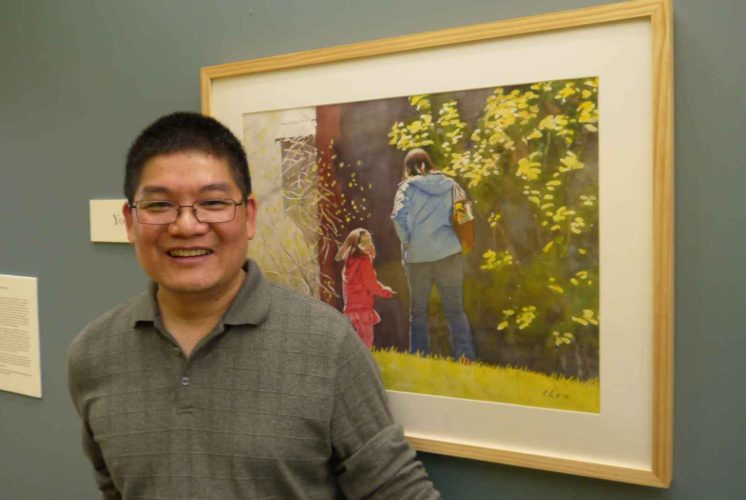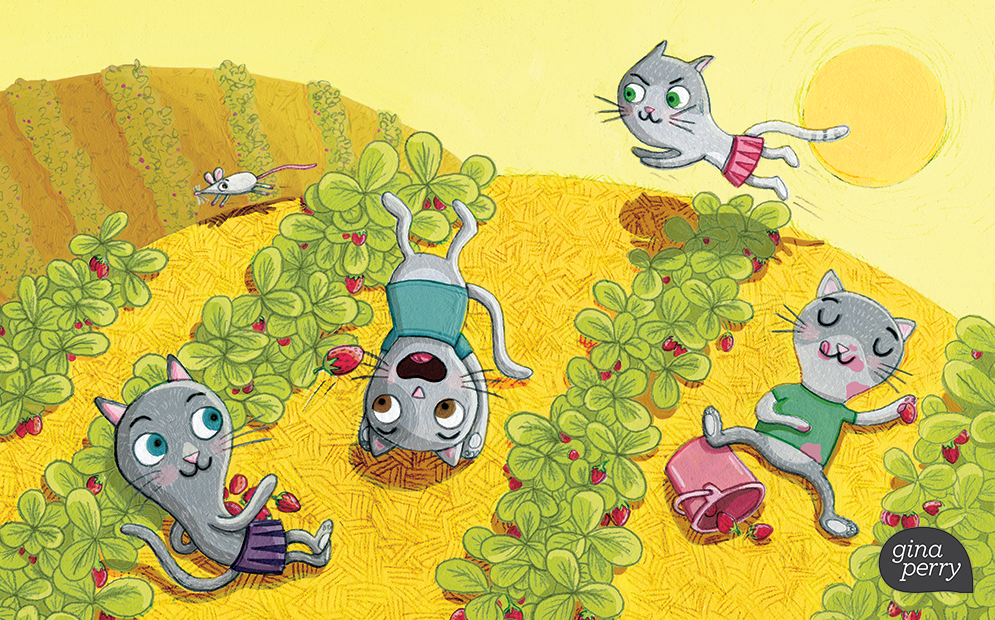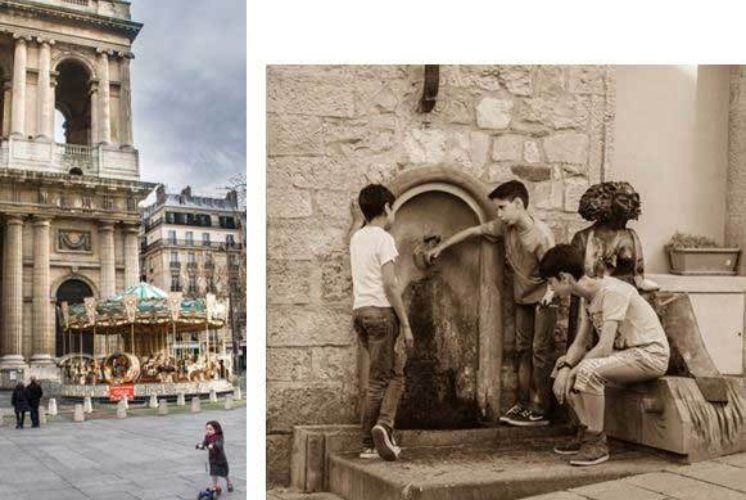The Museum Blog
Category: Art
Art Celebrating Diversity


Every spring, the Children’s Museum of New Hampshire in Dover creates a special art exhibition for our Gallery 6 space that aims to promote appreciation and inclusion of other cultures through the arts. This year’s “MOSAIC: Exploring Our Multicultural Neighborhood” art exhibition, on view through May 27, 2018 focuses on the stories, background and aspects of the cultures of recent immigrants and individuals from the community whose ancestors immigrated to this country in the past.
The exhibition, entitled “Immigrant Alphabet” uses the letters of the alphabet as a frame of reference for the museum’s young visitors. The art focuses on the unique contributions these families have made to the community and the richness derived from having a diverse population.
Each work of art in this exhibition was created by the students and faculty of the Dover Adult Learning Center, area artists, as well as friends and staff of the Children’s Museum of NH.
“M is for Mexico” features the smiling faces of Monica Ramirez and her three children. “My dream is that children around the world would be happy, healthy and smart,” says Ramirez in a statement next to her art. “We need to make a better place and help one another, no matter the difference.”
“G is for Greece” highlights the family history of CMNH Education Director, Xanthi Gray, going back to her Great, Great Grandparents, Zaxo and Vasilios Manias.
“P is for Perseverance” is a collage of photographs intermixed with small hand written notes telling the story of great grandparents from Kiev who “had to come to America to escape persecution. They arrived via Ellis Island and settled in Brownsville, Brooklyn, New York. Their families spoke four languages: Hebrew, Russian, Yiddish, and later, English.” This piece ends with this loving observation: “I am named after my great-grandparents, but I can only hope that at least an ounce of their chutzpah runs in my veins.
The exhibition’s introduction text says “Here are stories of love, family, courage, perseverance and determination as well as a celebration of the vast beauty of other lands. Together, they make up a fascinating MOSAIC. Perhaps this exhibition will inspire you to investigate more about your own Immigrant Experience.”
The public is invited to an opening reception on Friday, May 4 from 5-7pm. The opening reception coincides with the Dover Art Walk. Visiting any art exhibition in Gallery 6 does not require museum admission.
The Children’s Museum of New Hampshire would like to give a special thanks to Lien Harris, Deana Strand, Dalia Ahmed, Gracia Watkins, Jing Xiong, Nattawan Murphy, Sandra Cordoba, Sara Kazemiha, Monica Ramirez Echeverria, Laura Frincu, Marianne Torino, Bhuvanans Siddalingachar, Anu Onkari, Rani Sip, Xanthi Gray, Eric Erwin, Taylore Kelly, Julia Kirchmer, Susan McClure, Rebecca La Cain, Jane Niles, Nancy Hotchkiss, Ana Garnica and Kimberly and Kasey Tarr for helping to make this exhibition a success. This exhibition is sponsored by the generosity of The Jack & Dorothy Byrne Family Foundation, The Fuller Foundation, The Georgia-Pacific Foundation, Abbie F. Moseley Trust, Newburyport Five Cents Charitable Foundation, and the New Hampshire State Council on the Arts. The museum’s MOSAIC program is supported by the Eastern Bank Foundation.
Visiting Artist Week
By Meredith Lamothe, CMNH Early Childhood & Literacy Coordinator
I love art. I love going to art museums and looking at masterpieces—I always have. I’m pretty crafty and have managed to make some art-like creations. I enjoy coming up with activities in our Muse Studio and finding ways to make them about the process of art rather than the final product (a subject that deserves its own blog post!). As I sit at my desk right now, I see Experience Guide Amanda outside doing our “Chalk Art” kit—no visitors have joined her yet, but she’s happily drawing a lovely rainbow near the entrance to the museum.
There’s just something about art, isn’t there? It can be whatever you want it—or need it—to be. For Amanda right now, it’s a calm moment before she gets back to her many tasks inside the museum. I’m more of a crafter and get a lot of joy from giving finished crafts to people I love. Art can be purely fun (have you seen the projects where you throw water balloons at a blank canvas?!). Art, especially with kids, can be a great way to visually see some of the fascinating growth that is happening—from drawings of stick figures with arms coming out of their heads, to beautiful clay sculptures and beyond.
As fun as art is on it’s own, just for yourself, it’s also great to have skilled instructors help out sometimes. They open our eyes to different art forms we may not have thought about before, introduce new materials to use to create, and have an abundance of knowledge and encouraging words to share.
And what do you know, lucky us, we have five incredible instructors visiting the museum next week! We’re thrilled to announce our first ever Visiting Artist Week here at The Children’s Museum of New Hampshire.
We will have five wonderful local artists joining us for workshops the week of July 24-28, 2017. A few of these artists were guests at our “Visiting Artist Camp” last year and the final products that those campers produced were nothing short of remarkable.
Workshops will be from 11am - noon each day and are included with museum admission and free for members. Workshops may be best for children 6 years old or older, but would be fine for younger children with some help.
Monday, July 24th: Neva Cole
Neva, the Communications Director here at the museum, will encourage families to tear up, rip, cut and glue painted paper into collaged sea monsters! If a mermaid or pirate find their way into your scene, even better!
Neva is a multimedia artist and illustrator who is not the least bit ashamed to admit she spends a ridiculous amount of time with paint on her hands.
Tuesday, July 25th: Tess Feltes
Tess, the curator of Gallery 6 here at the museum, will be sharing some of her watercolor knowledge! Did you know all birds start from eggs? Of course you did! But! Did you know that bird paintings start with egg shapes?
Learn to draw and paint birds using simple geometric shapes with Tess!
Tess has illustrated numerous scientific books and articles and she is going to share some tricks of the trade.
Wednesday, July 26th: Cindel Lamothe
Cindel, an expert seamstress, will be here explaining a bit about the process of sewing—from patterns to fabric to putting it all together into a fabulous final product! What will be the final product of your hard work on the 26th? An adorable felt dinosaur that you can put on a pillow, apron, or frame and put on your wall!
Thursday, July 27th: Gina Perry
Learn how to draw imaginary creatures with children's book illustrator Gina Perry. She will show you, step-by-step, how to draw a Unicorn, Bigfoot, Loch Ness Monster, and a Mermaid. Watch out - you might even learn how to draw a Dragon!
Friday, July 28th: Francois Lamothe
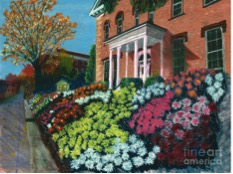 Seacoast pastel & acrylic painter Francois Lamothe will be here to share his skills. Francois will be sharing some tips and tricks about painting flowers using chalk pastels! Be sure to come prepared to get messy—this unique art experience is sure to accidentally travel onto clothing (it’s washable!)
Seacoast pastel & acrylic painter Francois Lamothe will be here to share his skills. Francois will be sharing some tips and tricks about painting flowers using chalk pastels! Be sure to come prepared to get messy—this unique art experience is sure to accidentally travel onto clothing (it’s washable!)
We hope you will join us for a day or two of Visiting Artist Week. It’s sure to be a lot of fun and you’ll learn some unique new skills as well.
Oh! In case you’re interested, some visitors have joined Amanda and her chalk outside now and have added frogs, fish, a yellow submarine, and some very large flowers alongside her rainbow!
Unconventional Materials: Artist Interviews
Nancy Morgan
by Rebecca Scheinberg, CMNH Intern
Q. In your artist statement you mentioned having a background in dance. You also mention discovering and using the free-style quilting technique. I really enjoyed the technique used in the sky of your landscape pieces. It guides the eye all around the pieces in an organic way.
What is free-style quilting and how do you think it contributes to the layering and movement in some of your pieces? What was the reason you chose quilted fabric to create your image of Strawbery Banke/Goodwin Mansion?
A. Free style quilting refers to the setting on the sewing machine. Typically, a sewing machine moves either forward or backward. The fabric is propelled by teeth or "feed dogs" located under the fabric that pushes it along. With a switch on the machine the "feed dogs" drop under the surface of the machine thus creating a smooth working surface. This allows the user to draw with the sewing machine by freely maneuvering in any direction.
The stitching seen in the sky and most other parts of the quilt is called "Stippling". It is a meandering solid line that enables all the parts of the piece to be equally quilted.
All my pieces are quilts. There is batting in the center, a solid piece of fabric on the back and the front consists of several layers of individual pieces of fabric sewn down in layers much like a collage. My love of fabric comes from my background in dance and the many costumes I designed and sewed for myself and many others.
Danielle Festa
Q. I really enjoyed the depth created by your use of unconventional materials. Did the idea inspire the use of materials or vice versa? How did you apply the paint to the woven work?
A. The inspiration for the unconventional materials in my paintings starts from the moment I find my subjects. I bounce my ideas for the materials I will use off of what they were wearing in real life. "Woven" was actually hand woven with yarn inspired by my subject's hat. Before I could pick up an oil paint brush, I had to prepare the surface by spackling plaster, sanding it down and applying several layers gesso. A true one of kind piece and a labor of love, this painting took about 6 months to create!
Eve Corey
Q. Your paint application on the plastic pieces produces a sense of movement on a hard plastic material. What inspired you to use plastic and is there a meaning behind the portal series (3) in terms of texture and color choices? How did you create the layered effect of the plastic pieces?
A. I am interested in 'alchemy'--- turning something into something else. These piecs are picture frames used to frame photographs. I decided to make them into art.
I love working with the square and when I saw these pre-made frames, I challenged myself with the task of converting them into something else. I also love working with 'found' materials. A portal is an entrance, a doorway, a gate to some place else; just as these pieces are. Color choice is empirical- a matter of testing out different colors until something works and this leads to the texture, colors superimposed over others.
Michal Smiglowski
Q. You created birds out of wood and paper and created a scene that encompasses the birds and scarecrows in your piece of art. What inspired you to create this 3-dimensional box that created a scene using a variety of unconventional materials? Did the creation of the birds inspire the overall direction of the piece?
A. I usually get inspired by something I see. An article in the New York Times about scarecrows got me thinking about creating miniature versions. The creative challenge is taking that or any idea and transforming it into artwork; solving questions like what materials, design, frame work and style, etc, to use. I had already created birds so this was a great way to combine the two, and also play on a 'friendlier' version, where the birds are welcome instead of being scared away. The creativity for these could be endless.
Judith Cassell
Q. You used copper, silk and wood for one of your pieces. In another piece you used copper, wood, silk, sand and paper. There is a beautiful contrast of hard and soft material that creates a very textured and layered effect. What inspired your combination of materials?
A. I have been an observer as long as I can remember. Memories of a long life are stashed somewhere beyond my eyelids and surface in unexpected moments of creativity. One of my earliest memories was drawing in the dirt beneath the swing. I remember the softness of the soil on my fingers, the warmth of the sun on my back and the thrill of creation. Today, seventy plus years later, I am still thrilled by the magic created by an unknown self. I like working with metals particularly copper and rusted steel. I like the contrast of silk, paper, sand, etc., that together form the layers of my imagery.
Beth Wittenberg
Q. There are so many layers of images and lines in your pieces. Is this an organic process for you? What inspired you to use the acrylic and markers on vinyl? What inspired your design?
A. The process is organic indeed. I have nothing in my mind when I start. I have an urge after I hang the canvas as I ready myself to work. The urge comes as a cathartic explosion. I make marks and lines and shapes. My process leads me from one mark to the next. I build the composition without any thought to the images or marks. A lot of time I see eyes in what I'm drawing. The process is similar to looking at clouds. I look for patterns and eyes. I continue working until the picture plane is full with lines. Then I begin adding the color. Some parts of the painting come to the surface, while others disappear. I am constantly pushing and pulling different layers back and forth. I am hoping to get a hybrid. Something that lives in the various planes. My drawings/paintings are inspired by my spirituality. They are about a relationship with something other. I am simply a medium for the creative energy that lives inside me.
The use of markers/acrylics on vinyl is inspired by spacial dimensions. I love how all of the layers lay on top of each other. This is achieved by the vinyl - it's see through. Lines sing to me and the layers play mind games with me.
Lin Thorpe
Q. Your illustrations of dinosaurs on the black converse children's shoes are beautiful. What inspired your idea to paint dinosaurs on converse kid shoes?
A. I have been illustrating on Converse sneakers for many years. My first pair was a special request from my son, then 15 (he's now 43) for a pair of dinosaur sneakers like the little kids had. He couldn't understand why only people with small feet could have such fun shoes! So I bravely tried a new type of "canvas" and painted a pair of size 11 light blue Converse Chucks with acrylic paint. He wore them proudly. Since then I have painted many pairs with very diverse subject matter, mostly for children but some for individualistic adults: frogs and amphibians; insects, beetles and tarantulas; exotic flowers; butterflies; seashells and sea life; and even images of Greek mythology done in Greek red-ware style. Each pair is a challenge and it is rewarding and fun to see people wearing a bit of my artwork on their feet.
I now illustrate on almost any surface I can find - shoes, furniture, rocks, fabric, driftwood, and of course paper. It's fun to transform an otherwise uninteresting surface into a creative, and often useful, work of art.
Barbara Albert
Q. You created a piece using acrylic with plastic netting and plastic lids. Your piece has a beautiful combination of texture and movement. What inspired your color choices with your unconventional materials?
A. As an abstract painter fascinated by texture and color, I was delighted to share “Blue Bird with Oranges” with Gallery 6 visitors. Painting is play for me – a series of “what ifs…”. This painting surprised me with a surprise blue bird when I stepped back to see where the color on the canvas was taking me. I squeezed red and yellow paint right from the tube onto the canvas and “squoooshed” them with clear plastic lids. Like magic, they turned into oranges for my blue bird to eat! The painting evolved with happy purples and blues that told more of the bluebird’s story. If you listen carefully, can you hear his “thank you” song?
Caryn Duncan
Q. You used CDs layered on top of records and paint to create beautiful mandalas. In your artist statement you mentioned utilizing objects that are being discarded and replaced with digital media. You also shared that mandalas represent the meditative practice in art. Did your choice of materials inspire you to create the mandala?
A. I draw inspiration from the belief that art makes a positive difference in the world. Spirituality is an essential aspect to my creative practice. There are a variety of spiritual elements, symbols, and personal beliefs that I weave into the layers of my paintings. The meditative practice of creating Mandalas supports my interest in sacred art. I choose to utilize materials that would support the radial balance design of Mandalas. Using unconventional materials that are discarded supports my belief that as artists, we can make powerful visual statements to convey messages. It is my hope that humans can cut back on the waste that goes into landfills, that we try to reuse and extend the life of items that are being discarded. This comes from my deep care and appreciation of nature and preservation of the earth.
Taintor Child
Q. You used re-purposed polystyrene packaging, paint, metal leaf and mirror to create beautiful and functional mirrors with "frames". Did the materials inspire the design idea or vice versa?
A. The materials definitely inspired the idea to create the mirrors. I had been working with the polystyrene packaging for a couple of years to create standing sculptures and found a number of pieces in my collection that had windows that were already a frame of sorts. I had a show coming up and wanted a collection of new works to hang and decided to play with the mirror idea. The concept that we are looking through a piece of EPS at ourselves got me jazzed. Yes, EPS is a problematic by-product of consumer waste and the question of what do we do with all this stuff we create is hopefully a question that arises when looking at oneself in these pieces. The other message I want to convey is that it is a beautiful creation, the molded shapes of EPS are designed by packaging experts to nestle and protect out beloved treasures. Then what? So many people will say to me, I hate to throw this stuff away. I think we save it in part because it is sculptural and we find it interesting. What do you think?
Joe Kennedy
Q. Your work has a playfulness and whimsy about it. There is a sense of heaviness from the plumbing materials and lightness from the glass materials. What inspired your combination of using plumbing materials with glass to create these sculptures?
A. I’ve come to love the combination of metal and glass over time. Almost immediately when I started experimenting at my bench, I found myself working to incorporate glass because it was available. I delighted in the discovery that both materials work so well together despite their stark differences. The metal, being heavy, dense and dark, in contrast to glass with its sense of lightness – it signified the water that once flowed through the transformed plumbing parts.
I only work with glass that allows light to pass through. It becomes a portal to another world and brings in color. Marbles were the first type of glass I used quickly followed by many other forms such as mirrors, magnifying lenses, domes, containers, vases, etc. I often use glass for stands, shrines, finials and many types of display. I’m prone to using some sort of glass encasing such as domes for a number of reasons – It elevates the piece to a higher level, keeps the dust off and it naturally keeps people from handling a delicate piece of sculpture. Also, as you noticed, it enhances the overall quirkiness of my work adding to the obvious whimsy and playfulness.
Elizabeth Doherty
Q. Did your love of dragonflies inspire you to find ways to create them using unconventional materials? Did you know the materials you wanted specifically or did you find the pieces and construct as you went along in your design process?
A. I knew I wanted to make dragonflies. I was thinking at first the wings would be made of layered recycled bags fused by heat and transparent but then I found the license plates.
I researched some ideas from the inter web and a rummage through my dads workshop (the basement) and the cuties came together.
Everything Under the Sun: Artist Interviews
Susan Mariano, CMNH Intern
Barbara Albert
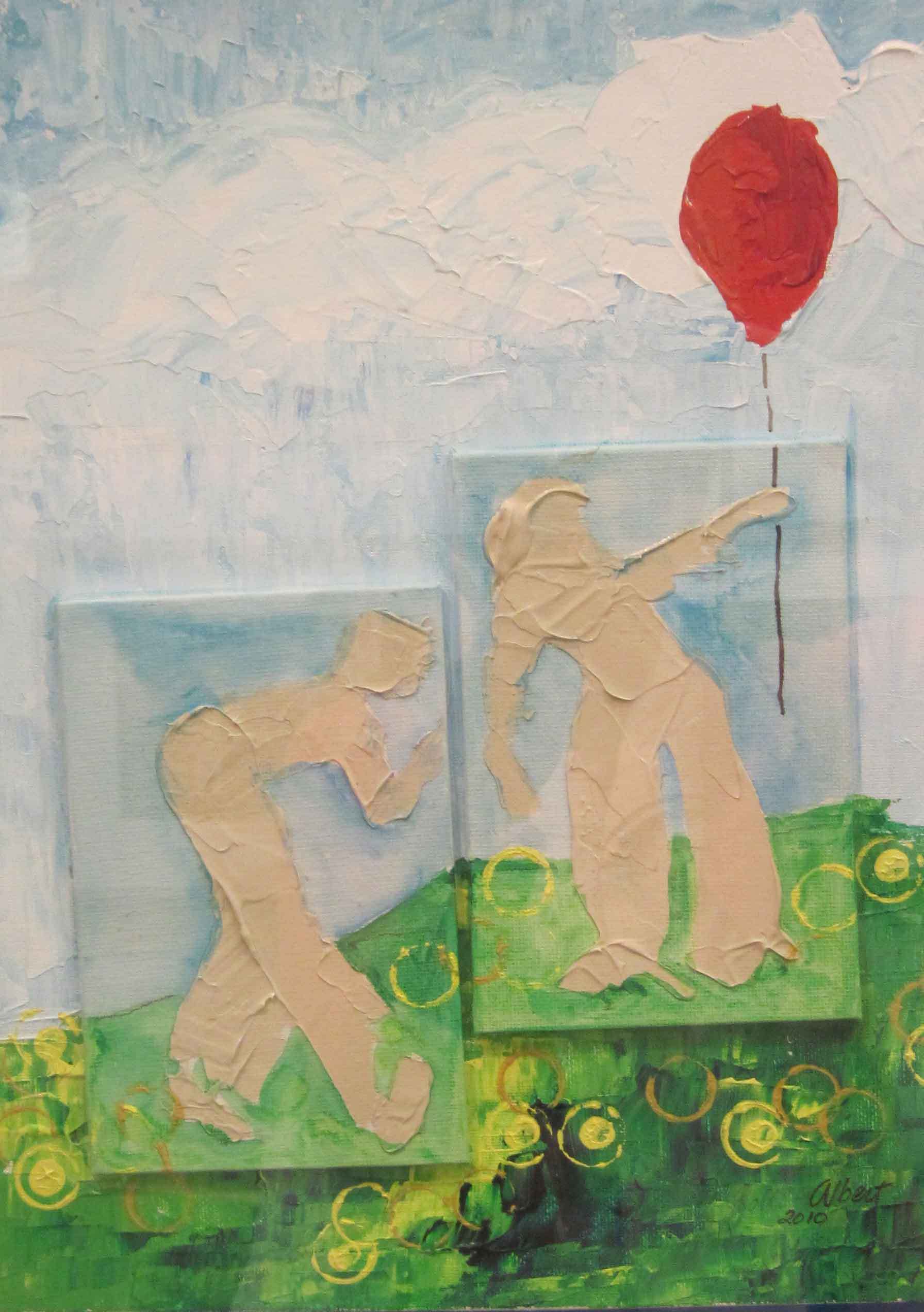
Q. Barbara, I really like the way that you have added dimension to your painting by affixing the smaller canvases of the two children on top of your hillside background canvas. The way the string of the balloon appears in the foreground and balloon itself in the background, makes it seem as though the balloon belongs to the children, yet has a separate existence of its own outside of their play.
What feeling or message are you hoping to
invoke with the viewers of “The Red Balloon”?
A. Children often struggle with sharing. My painting of two kids with a red balloon, tells a story about making choices. Look closely at the boy on the left. Does the way he is standing suggest that he wants to hold the balloon, too? You can feel the boy wanting to hold the string while the girl on the right seems unwilling to share her prize. Do you think the girl on the right will let him? Will he convince her to let it go? Will the balloon escape at first opportunity? If it was your balloon would you share it?
Yong Chen
Q. Yong, the detailed facial expressions in your paintings are very moving and being able to watch you actually paint a portrait during the artists’ reception was incredible! The watercolor paintings that you have chosen for this exhibition truly capture the emotional element of childhood play when there is not a care in the world but the moment that you are living in, and the sense of security found in spending unhurried, quality time with treasured parents.
What is it that
catches your eye and creates the desire within you to paint a particular
person?
A. Whenever I see happy children under the sun, I want to put them in my paintings, because I would feel the genuine, unselfish love from the parents. I hope that my paintings will inspire my viewers to spend more quality time with their children.
My core belief that guides my parenting is that children are happier when they're outside, in the sunshine, playing, enjoying, exploring and learning about the wonderful world they live in. I'm experiencing the same struggle as most parents do of how to balance life and work in the modern technologically obsessed environment around us. For many working parents, it is very difficult to consistently make their children the priority. In each of my watercolor paintings in this series, there is one story to tell, and behind it a very happy child. We should see the love, caring and sacrifice from the parents. As an illustrator, I am trying to use my paintings to connect the parents with their own happy childhood memories, when in those times there was not much technology, and share my thought with them that they should make time to bring their children outside and play.
Taylore Kelly

Q. Taylore, the golden circular shapes in the center of all of your mixed media artwork convey a sense of warmth and security, as they surround the delicate creatures within.
What statement are you making with the vintage printed backgrounds that you have chosen for each of your pieces?
A. I like to up-cycle the vintage pages from damaged antique books that would have otherwise found their demise and give them a new life by creating on them.
Q. Would you share your thoughts on your unique title choices?
A. Then All the Sky Which Only, the hummingbird, has the specific background because I saw the sentence, “Nature of Matter and Mind” within it and I turned it into my belief system of nature being grace, and that I do not understand, nor do I need to understand the mystery of grace. The title is simply a sing song way to say “Look what the sky holds! Hummingbirds!” Words have melody when we look and search.
By All and Deep by Deep, the whale, has a mathematical equation background because when I squinted my eyes the equations looked like music notes. Well let’s be honest I am far sighted and thought, indeed they were music notes. I love the songs whales sing. The title is because whales seem to live very deeply on all levels, figuratively, literally, musically, richly.
Whatever a Sun will Always Sing is You, the fox in the eclipse, is on a page about insanity, but the page is reversed. Tarot Cards meanings at times will be the complete opposite if inverted. Actually a lot of symbols mean the opposite when inverted. A subliminal message of how rabies seem to get these lovely creatures quite often, but not this one. She is sleeping in a soft eclipse of her own music.
Open You the Biggest and All, the deer, is in a sun nest. She is open and feels one with the Universe and what is bigger than that? I can not think of anything. She is on upside down equations as well because I thought they were music notes. Sometimes these things happen and I just flow with them!
Gina Perry
Q. Gina, I really love the way that your colorful illustrations have captured the whimsy of a child’s imagination, the details that you put into your work, and how each person and creature is sharing time with others, yet in their own little world.
What made you decide to become an illustrator?
A. My short answer is usually that a very big part of me is STILL a child, and I'm making pictures that make that part of me happy! But here is the long answer, as well. Books were a huge part of my childhood. They allowed me to see into other worlds that as a child I couldn't travel to on my own. I also loved art from a young age but never thought of illustration as a career path until I was in art school. Even then, I studied computer animation - and I think what most attracted me to that profession was the visual storytelling. Once I was working in animation, I understood how little personal vision I could put into a project and that I wasn't working with the audience I loved the most - children. I didn't put the pieces together until I was taking a children's illustration class - suddenly I knew exactly what I wanted to do! It really felt like a light deep inside me finally clicked on. I love learning, so I soaked up everything that would help me reach my goal. Over the years I took lots of classes, joined critique groups, attended conferences, read mountains of picture books, and worked incredibly hard to find a place in children's book illustration.
Q. Do the authors set “rules” for you limiting you to their vision or do you get to express what you see within your own imagination?
A. Most projects allow me to set lots of rules - from how the characters look to the size of the book itself and where the text breaks up throughout the book. Other projects come with more guidelines, usually from an editor or art director, but there is always room for my own approach and vision. Finding ideas and characters that the author didn't originally state, but that add to the story, is one of the most exciting parts of my job!
Q. What medium to you use to craft your illustrations?
A. I use a mix of gouache (opaque watercolor), soft pencils and Photoshop.
Michal Smiglowski
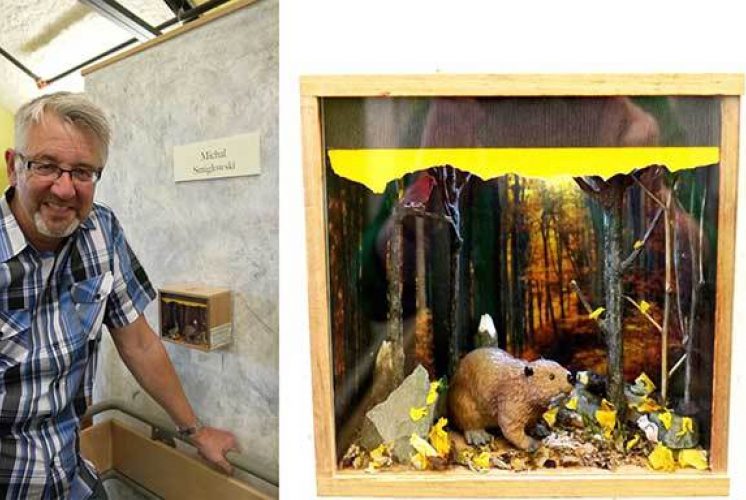
Q. Michal, you are known for drawing incredibly detailed black and white penciled portraits and illustrations. In this exhibition you have traveled in a totally different artistic direction, leading you to the creation of fascinating 3-dimensional, illuminated worlds inside of cigar boxes. In conversation you eluded to a future endeavor using yet another medium.
Please share what it is that truly inspires you to boldly go where you have not gone before.
A. On a visit to our favorite Maine 'Dowling Walsh' Gallery, located in Rockland, we came across artwork the likes I had never seen before. I was immediately fascinated by the medium, craftsmanship and story. The artist is Anne Emmanuelle Marpeau from Brittany France. The works were of dioramas of the coast, sailing and sea. I was so taken with them I got to thinking about creating something similar on a smaller scale, and so after much experimentation and development my boxes were born.
Less exacting than my pencil portraits and entirely different, I
loved the change in medium and the unending and imaginative ideas you
could create.
I am always coming up with new ideas and creative projects, adding
them to my repertoire of artworks. The part I quite enjoy is figuring
out (engineering) how these 3 dimensional projects can work, and yes, I
have yet another idea in my mind… here we
go again. It's so much fun!
In the world of hi-tech, the hand-crafted creative is both rewarding and therapeutic.
Debra Woodward
Q. Debra, I like that you selected photographs of children from France, Mexico and Italy for this exhibition as your photos serve as a reminder that the essence of being a child has no international borders. Your statement that “Photography is so much about ‘seeing’ and not just taking snapshots,“ rings so true with your photographs. As the viewer continues to gaze at one of your photos, it seems that there is more going on than just a quick glance can reveal.
Do you see these nuances as you are taking the photo or discover afterwards that they were what compelled you to capture the image?
A. Thank
you for saying that my photographs are not snapshots, but more about
seeing. That is what I strive for. As for whether capturing the
essence of being a child was intent or a lucky result of my shooting
(which I admit can absolutely happen!) on those days in Mexico, Paris
and Tuscany, I think I can fairly say that with these particular photos I
was excited to see what was happening in the world around me and sought
to capture the moment. The child in Mexico was playing with some of
the jewelry that her parents crafted and sold and I could see that she
was just so beautiful. In Tuscany, I shot many images of those boys
playing soccer but was happy that I stuck around to photograph
their camaraderie afterwards. And in Paris, I was very excited to
see that little girl on her scooter in front of the carousel. It was an
image I would never be able to capture close to home. It was so
Parisian. She reminded me of the little girl in the Madeline books!
Finding the Summer in STEAM
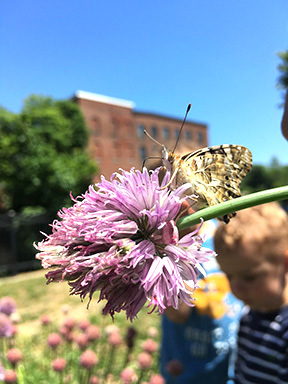 by Sarah Terry, Museum Educator
by Sarah Terry, Museum Educator
Could it finally be summer in New Hampshire? This winter child is a little sad (and hauling up the air conditioners from my basement…), but it’s hard to feel too badly when all the trees and flowers are in bloom!
I’ve been watching our museum garden start to grow out back – we have a ton of different herbs, all kinds of vegetables poking their stems up – and contemplating my unfortunate black thumb. I’ve never really been able get anything to grow except aloe plants (which apparently thrive on neglect), so I’ve been thinking a lot about the science behind growing things, the way plants and animals fit into their environments, and the effects, both positive and negative, that human beings can have on those environments.
It’s with those thoughts in mind that I’ve decided it’s high time to dirty up our fancy new STEAM Lab a bit! For the month of June, all of our lab activities are going to be focused on ecology.
I chose ecology in particular because it focuses on how all the elements of our environment work together. Ecologists look at plants, animals, soil, people – all the pieces of the puzzle. That’s what I’m hoping kids and parents will get a taste of in the lab this month.
And taste may be literal! I’m planning on growing some oyster mushrooms in the lab for kids to inspect, as well as planting some pea plants. We’ll be looking at strawberry DNA, making seed bombs, learning about beavers, making biomes in a bag, and even raising some butterflies!
We’ll be posting our STEAM Lab schedule weekly, so make sure to check our Facebook page and calendar for updates!
And who knows – maybe I’ll even get to upgrade my black thumb to something a little greener! Wish me luck!
MOSAIC: Artist Interviews
By Susan Mariano, CMNH Intern
BECKY FIELD
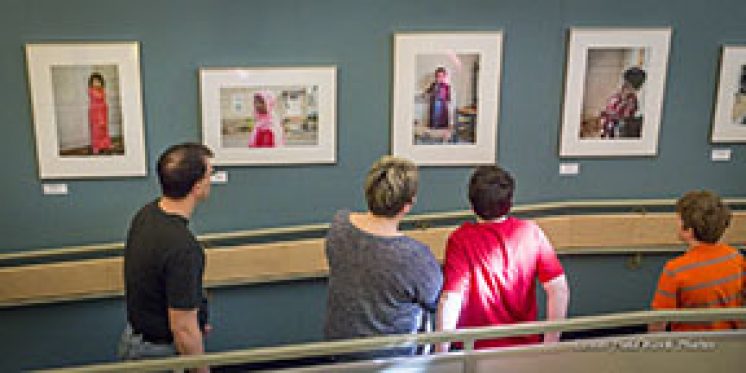 Q. Your photographs capture the optimistic joy of childhood and the strong desire to embrace and rejoice in the freedom to express, celebrate and share one’s colorful cultural heritage. While the immigrants and refugees from Africa and Southeast Asia may outwardly look and dress differently than those born here in the United States, they share many of the same family values as their fellow American-born neighbors and should be respected and appreciated for their differences.
Q. Your photographs capture the optimistic joy of childhood and the strong desire to embrace and rejoice in the freedom to express, celebrate and share one’s colorful cultural heritage. While the immigrants and refugees from Africa and Southeast Asia may outwardly look and dress differently than those born here in the United States, they share many of the same family values as their fellow American-born neighbors and should be respected and appreciated for their differences.
Many of the people you have immortalized on film have come to New Hampshire seeking safety and a better life for their children. However, it was a shameful local act of hate that inspired you to begin your photographic journey. What signs have you seen that the tides of understanding and embracing cultural diversity are changing here in New Hampshire?
A. The act of hate that inspired me to do this photographic project was immediately countered by a large community response that started the "Love Your Neighbor" Coalition. The hate was from one person, the response was from a whole community. Since then, my photography has been shown in many exhibits and talks that I have given in several New Hampshire communities. I have seen in the response to those events that feature the lives of our immigrant and refugee neighbors, and in the out-pouring of interest in by book, Different Roots, Common Dreams, that there is a growing interest and desire to welcome for people of different cultures who resettle in our communities. Through these photographs, the broader public has come to know our immigrant neighbors, and that knowing has planted the seeds of understanding and compassion.
SKIP SMALL
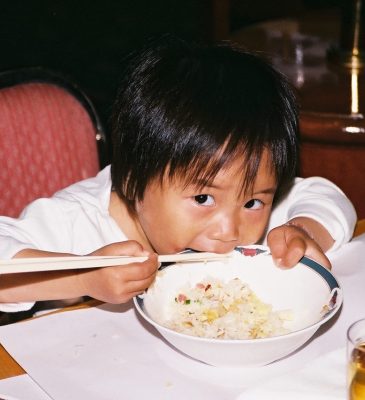 Q. The photographs you have taken of Chinese children living their everyday lives, hanging out with friends, riding on a bicycle and playing outside in the dirt illustrate that the simple things that bring one joy during the days childhood are pretty much universal.
Q. The photographs you have taken of Chinese children living their everyday lives, hanging out with friends, riding on a bicycle and playing outside in the dirt illustrate that the simple things that bring one joy during the days childhood are pretty much universal.
As a retired pediatrician who accompanies groups of prospective parents on the journey to meet their adoptive children for the first time, what would you like to say to couples who are considering becoming parents to children from other cultures?
A. My advice to people thinking of adopting children from a different culture would be no different than I would give to any potential parents. Raising children is a demanding challenge whether they are naturally yours, adopted from your culture, or adopted from a different one. If you are afraid of challenges, don’t have kids. If you embrace challenges, go for it!
SAYAKA and SETH BLEWITT
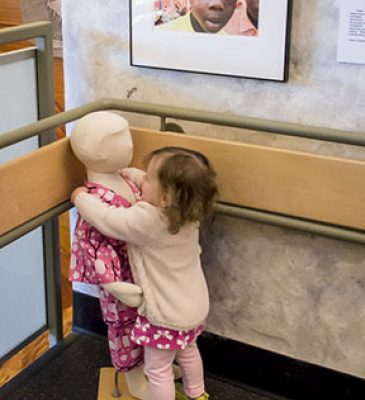 Q. The images and objects that you have curated, providing a glimpse into the life of a child from Japan, were uniquely enlightening. Finally, I understand the significance of the Japanese cherry blossoms! The celebrations of Hina Matsuri and Tango no Sekku show how truly important and respected children are in the lives of the Japanese.
Q. The images and objects that you have curated, providing a glimpse into the life of a child from Japan, were uniquely enlightening. Finally, I understand the significance of the Japanese cherry blossoms! The celebrations of Hina Matsuri and Tango no Sekku show how truly important and respected children are in the lives of the Japanese.
What message are you hoping the people who view your collection will take away with them?
A. I'm glad that the exhibit had that effect of providing some insight into Japan through a child's eyes. Think of the first moment when you saw the topics posted on the wall of the
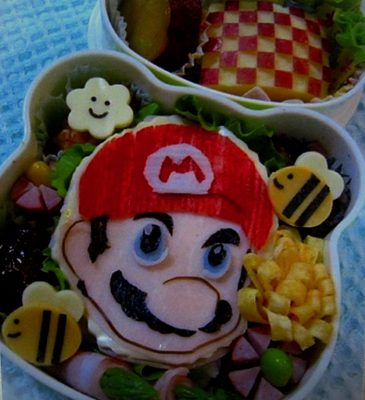
Curiosity, wonder, bemusement, and excitement for something new are a little harder to come by when you're older, unless you look for it. In exploring another culture, adults can feel like a kid again because they encounter a barrage of new experiences. So hopefully in the short term visitors, adults and children alike, have found these wondrous emotions. And in the long term I hope that this exhibit has motivated adults to seek out new experiences for themselves and to share with others.
A MOSAIC of Cultures to be Explored
Gallery 6, the space reserved for art inside the Children’s Museum of New Hampshire, will have a new exhibition opening on March 5 and featuring art from many different cultures. MOSAIC: Exploring Our Multicultural Neighborhood will be paired with a special celebration of cultural exploration on Saturday, March 12, where guests can taste North African cooking, enjoy traditional Bhutan dancing and music, try their hand at Chinese brush painting and take part in a community art project.
The art on view in MOSAIC will include photographs of immigrants and refugees living in New Hampshire taken by Becky Field from her book Different Roots, Common Dreams, which came out in the Fall of 2015. Photographer David Hiley, who traveled to Haiti with a group of Seacoast, NH medical professional volunteers in coordination with the Haitian Health Foundation, will present his series of Haitian “selfies” of children and parents. “My eye was drawn to the tension I saw between wrenching poverty and the vibrancy and dignity of these children,” shared David. “Allowing the children to take selfies captured the curiosity and joy common to children everywhere.” Also on view will be photographs of children from China taken by retired pediatrician Skip Small and a glimpse into the life of a child from Japan curated by Sayaka and Seth Blewitt. Also on view will be selected dolls from the Museum’s collection of dolls from around the world.
The special celebration of MOSAIC promises to be just as diverse as the cultures represented in the art itself. The event will be from 11am-2pm on Saturday, March 12 at the Children’s Museum of New Hampshire in Dover. Guests who come in traditional cultural costumes (super heroes and princess costumes do not apply) will receive half-off their individual admission. From 10:45am-Noon European classically trained chef Patrice Gerard will demonstrate North African cooking and guests can taste his vegetarian tagine with couscous. Becky Field will be on hand to talk about her photography project and her work documenting cultural, ethnic and religious diversity in NH. At 11:30am and 1pm dancers from Bhutan will demonstrate traditional dance and music in the Museum’s Muse Studio. David Hiley will be walking around the Museum taking “selfies” of guests who come dressed in their traditional costumes. Runjuan Huang will demonstrate Chinese brush painting and guests can try their hand at that or help create a community weaving project, which, when completed, will be installed on the exterior of the Children’s Museum. The opening celebration events are free with regular museum admission.
The MOSAIC exhibition will be on view through Tuesday, May 31 and is sponsored by Optima Bank and Trust, the New Hampshire State Council on the Arts and the Fuller Foundation. In addition to the art on view and special celebration event, every two weeks the Museum educators will focus on the cultures of different countries and feature country themed crafts and activities in the Muse Studio. The countries, in order of appearance, will include Tanzania, Peru, Haiti, Iceland, Japan, Pakistan and Canada. At the end of May, art projects and facts about all seven countries will be displayed together in the Muse Studio.
As always, no admission fee is required to view the art in Gallery 6. Regular admission applies for families who wish to also explore the rest of the Museum.
Un MOSAICO de Culturas
Un MOSAICO de Culturas para ser Exploradas en el Museo del Niño de New Hampshire
Galería 6, el espacio reservado para el arte en el Museo del Niño de New Hampshire, tendrá la apertura de una nueva exhibición el 5 de marzo, y presentará el arte de diversas culturas. MOSAICO: Explorando nuestra comunidad Multicultural, simultáneamente llevará a cabo una celebración especial de la exploración cultural, el sábado 12 de marzo, en donde los asistentes podrán degustar la cocina del Norte de África, disfrutar el baile y la música tradicional de Bután, probar sus destrezas con el pincel en la pintura China y formar parte de un proyecto de arte comunitario.
El arte visto en MOSAICO incluirá fotografías de inmigrantes y refugiados que viven en New Hampshire tomadas del libro Raíces Diferentes, Sueños en Común de Becky Field, el cual salió en el otoño del 2015. El fotógrafo David Hiley, quien viajó a Haití con un grupo del litoral, profesionales médicos voluntarios de NH en coordinación con la Fundación Sanitara de Haití, presentarán las series ‘selfies’ de niños y padres Haitianos. “Me llamo la atención lo que vi entre la desgarradora pobreza y la vitalidad y dignidad de esos niños”, “comentó David”. “Permitiendo capturar la curiosidad y alegría en común que todos los niños tenían por todas partes”. Asimismo serán expuestas fotografías de niños de China, tomadas por el pediatra jubilado Skip Small y se vislumbrará la vida de un niño de Japón capturado por Sayaka y Seth Blewitt. También estarán en muestra muñecas de alrededor del mundo seleccionadas de la colección del Museo.
La celebración especial de MOSAICO, promete ser tan diversa como las culturas presentadas en el arte mismo. El evento se llevará a cabo de 11am-2pm el sábado 12 de marzo en el Museo del Niño de New Hampshire en Dover. Los asistentes que vengan en sus trajes típicos (disfraces de superhéroes y princesas no aplican) pagarán la mitad en su admisión individual. De 10:45 am-a mediodía el chef Patrice Gerard capacitado en Europa, hará una demostración de la cocina del Norte de África y los invitados podrán degustar su tajine vegetariana con cuscús. Becky Field estará accesible para hablar de su proyecto fotográfico y su trabajo de documentación cultural, étnico y la diversidad religiosa en NH. A las 11:30am y 1pm bailarines de Bután harán una demostración de su baile y de su música tradicional en el Estudio Muse. David Hiley caminará alrededor del Museo tomando “selfies” a los invitados que vengan vestidos con sus trajes típicos. Runjuan Huang hará una demostración de la pintura China con pincel y los asistentes podrán también intentar hacerlo o ayudar a crear el proyecto comunitario, el cual, una vez completado será colocado en el exterior de Museo del Niño. La apertura de la celebración de los eventos son gratuitos con su admisión regular del museo.
La exhibición MOSAICO estará a la vista hasta el martes, 13 de mayo y es patrocinada por Optima Bank and Trust, el Consejo Estatal de Artes de New Hampshire y la Fundación Fuller. Además de la exposición de arte y la celebración especial, cada dos semanas los educadores del Museo harán manualidades y actividades culturales de diferentes países en el estudio Muse. Los países, en orden de aparición, incluirán Tanzania, Perú, Haití, Islandia, Japón , Pakistán y Canadá. A Finales de mayo, proyectos y situaciones acerca de los 7 países estarán juntos en exhibición en el Estudio Muse.

